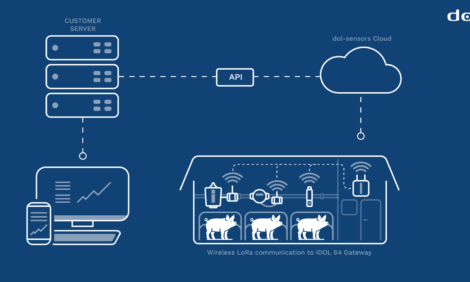



Market Impact of EU Regulations on Group Housing of Sows
Updating an earlier report, the British Pig Executive (BPEX) forecasts that, following the partial ban on sow stalls in the EU from January 2013, pig production in the region is likely to fall by between five and 10 per cent and that processors and retailers are likely to face substantial price increases. The organisation presents three possible scenarios following discussions with European partners, based on the experience of the battery cage ban for laying hens in January this year, the likely level of compliance in the different Member States and the Commission's response to non-compliance.New EU pig welfare legislation – Council Directive 2001/88/EC – comes into force on 1 January 2013. In this report, BPEX highlights the most significant and high profile element of the new legislation as the requirement that, with limited exceptions, sows and gilts are kept in social groups during a period starting from four weeks after service to one week before the expected time of farrowing. One effect of this is to prohibit the use of individual sow stalls during this period.
The regulations also cover a number of other issues which many consider to be less onerous to comply with. These include:
- specifying the amount of unobstructed floor space available to pigs of different ages and the minimum dimensions for pens
- specifying the width of openings and slats when pigs are kept on slatted floors
- ensuring that sows and gilts have access to manipulable materials, and
- ensuring that sows and gilts are provided with sufficient feed, including sufficient bulky or high-fibre feed to prevent hunger.
The new rules are likely to have an impact on the EU pig meat market, says BPEX, the scale of which will depend on the level of compliance by producers, the impact on the size and productivity of breeding herds and actions taken to enforce the regulations. Understanding the likely impact of the changes will help the industry to plan. Last year, BPEX published a report, which began to develop this understanding, drawing upon information which was publicly available at that time.
The aim of this report, according to BPEX, is to improve understanding by setting out the latest progress towards implementation and enforcement of the regulations and by developing scenarios for the market situation both before and after implementation. The report incorporates information provided by European members of the InterPIG group.
In early February, a meeting was held in Brussels involving representatives from Denmark (Landbrug & Fødevarer), Germany (Johann Heinrich von Thünen-Institut), the Netherlands (LEI Wageningen UR) and the United Kingdom (Agriculture and Horticulture Development Board). At the meeting, the current situation was discussed and the scenarios presented in this report were developed.
Executive Summary
BPEX forecasts that the partial sow stall ban due to take effect throughout Europe from 1 January 2013 is highly likely to have a major impact on the EU pig meat market:
- Pig production is likely to fall by between five and 10 per cent and processors and retailers are likely to face substantial price increases.
- Similar animal welfare legislation in the laying hens industry which came into force on I January 2012 has caused serious disruption to the egg industry where the price of shell eggs is 75 per cent higher than a year ago.
- The EU Commission had made it clear there will be no derogation granted and that the onus is on Member States to enforce the new legislation from 1 January 2013.
- To date, only three Member States have told the Commission they are already compliant with the new legislation; nine Member States have indicated they expect to be compliant by the end of this year; 12 countries have not been able to assure the Commission they will be fully compliant by I January 2013; three countries have not replied to the Commission’s request for such information.
- A number of Member States have indicated they expect a ‘significant number’ of producers to quit the industry or at least to stop breeding pigs and allow their herds to run down as they will be unable or unwilling to comply with the new legislation.
- While enforcement of the new EU welfare legislation lies with Member States, the Commission has made it clear it will initiate infraction proceedings against those countries that fail to comply with or enforce the legislation
- While robust enforcement will have an effect, it will not be the only measure to have an impact on the market. Many retailers, especially those in Member States where the pig industry is fully compliant with the new legislation, will be concerned about the possible adverse effect on their corporate reputations of being found to be selling ‘illegally produced’ pig meat products.
Three possible outcomes after I January 2013 are examined in more detail in the BPEX report.
Scenario 1: Most likely scenario
- Total EU pig meat production in 2013 would fall by five per cent compared with 2011.
- This would lead to a significant increase in price for finished pigs from compliant producers – by at least 10 er cent in all likelihood.
- Prices for pigs from non-compliant producers would probably fall as many processors and retailers would be unwilling to take such product.
- As there is already some over–capacity in the EU processing sector, the expected fall in pig production is likely to exacerbate the situation and lead to further rationalisation in the sector.
Scenario 2: Rigorous enforcement
- Rigorous enforcement throughout the EU, leading to pig production declining by up to 10 per cent.
- Production losses on this scale would lead to real shortages of pig meat in the EU market and would mean substantial price increases and processors and retailers competing for supply.
- Securing supply could be a greater priority than price.
- Price increases would inevitably be passed on to consumers, possibly putting pressure on politicians to act to increase pig meat supplies (especially in those Member States where per–capita consumption of pig meat is comparatively high).
- In that case, the options are to stimulate expansion of compliant production within the EU (difficult in the current economic climate) or to open up the market to imports from third countries. In this latter case, there would be difficulty in sourcing welfare compliant product on the world market.
- Longer term, the implications of such political moves would lead to major structural changes in the European supply chain.
Scenario 3: Fundamental realignment of production
- The third possible scenario would involve a fundamental realignment of production across the EU with breeding and finishing concentrated in different Member States.
- Following the initial fall in the size of the breeding herd in North West Europe, it would recover to expand rapidly and fill the gap left by production falls in other parts of the EU. Many breeders in Eastern and Southern Europe would switch to finishing, taking piglets from North West Europe.
- This might lead to a form of integration – with productive breeders in North West Europe supplying piglets to lower–cost finishers in Eastern and Southern Europe – and also lead to a reduction in overall production costs.
- A major barrier would remain in the form of animal welfare concerns with resistance to large–scale transport of piglets across Europe.
Further Reading
| - | You can view the full report by clicking here. |
Further Reading
|
| - | Go to our previous news item on this story by clicking here. |
April 2012






